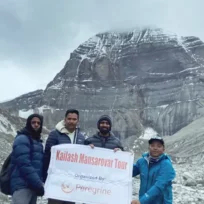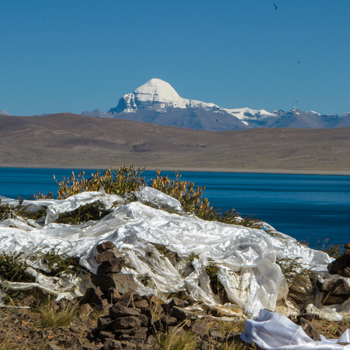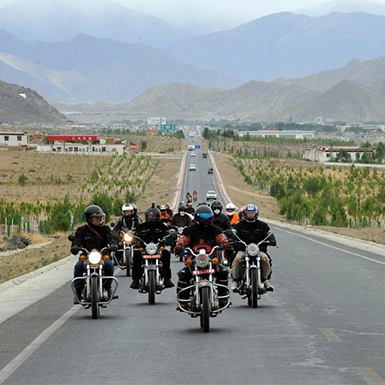Dolma La Pass, nestled in the remote Tibetan wilderness, embodies a harmonious blend of breathtaking scenery and profound spiritual importance. This imposing pass, reaching a staggering 5,630 meters (18,471 feet), is an iconic landmark in the Himalayas. It reveals stunning panoramas of the surrounding mountains and glaciers while holding deep significance for Tibetan Buddhists and those of various other faiths.
In Tibetan Buddhism, followers revere Dolma La Pass as the abode of Tara, the goddess of compassion and protection. It makes it a sacred site for prayer and offerings, symbolizing the release of past burdens and a step toward spiritual rebirth.
Dolma La Pass and the Mount Kailash Kora
The pass is pivotal in Mount Kailash Kora, a 52-kilometer (32-mile) pilgrimage circuit around the sacred mountain. Dolmala Pass marks the highest point of this challenging trek, both physically and spiritually.
- Physical Challenge: The ascent is strenuous and tests the endurance of even experienced trekkers. The combination of thin air, unpredictable weather conditions, and steep terrain demands meticulous preparation and a deep respect for the mountain’s formidable power.
- Spiritual Milestone: For pilgrims, reaching Dolmala Pass is a moment of profound significance. It’s a place to reflect on their tour, offer prayers, and leave symbolic tokens of past worries and negativity. Many believe that successfully crossing the pass brings them closer to enlightenment.
- Natural Beauty: Beyond the spiritual aspects, the pass offers breathtaking vistas. The panoramic views of Mount Kailash, nearby Lake Gauri Kund, and the surrounding Himalayan peaks are a reward for the challenging trek.
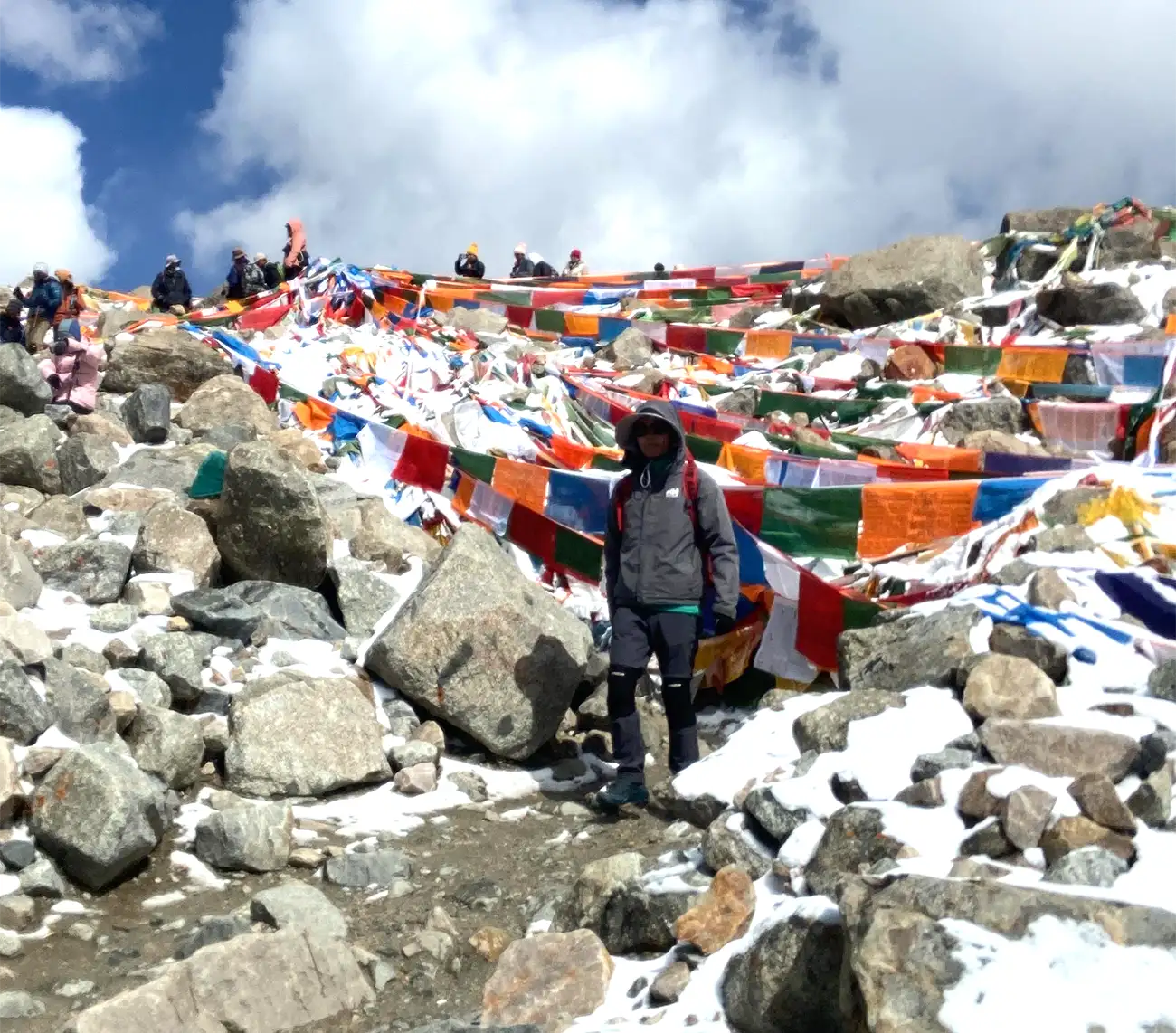
Tapestry of Faith and Legends in the Tibetan Highlands
Dolma La Pass is not just a geographical feature; it’s a spiritual crossroads steeped in rich history and religious traditions. This high-altitude pass is significant for multiple faiths, making it a pilgrimage, devotion, and ancient storytelling site.
Religious Significance of Dolma La Pass
- Tibetan Buddhism: The pass is closely associated with Tara, the goddess of compassion and protection. Pilgrims believe that traversing the past and offering prayers to Tara can cleanse them of negative karma and bestow blessings for their tour ahead.
- Hinduism: In Hindu mythology, Dolmala Pass connects to Parvati, the consort of Lord Shiva. It’s believed to be a place where divine energies converge, allowing devotees to connect with the goddess and seek her blessings.
- Bön Religion: The indigenous pre-Buddhist religion of Tibet, Bön, also holds Dolmala Pass as sacred. It’s a place of power where practitioners can engage in rituals and communicate with spirits.
- Jainism: Jains, too, revere Mount Kailash and its surrounding areas as places of immense spiritual significance.
Stories and Legends of Dolma La Pass
Numerous legends and tales surround it, adding to its mystique and allure.
- Milarepa’s Challenge: The great Tibetan yogi and poet Milarepa is said to have meditated in a cave near Dolmala Pass. Legend has it that he overcame a powerful demoness on the pass, establishing its sacredness for generations.
- Gatekeeper of the Sacred Mountain: Some stories describe Dolma La Pass as a gateway to Mount Kailash, where deities test the resolve and faith of pilgrims embarking on the sacred Mount Kailash pilgrimage.
- Miraculous Healings: Pilgrims often share tales of miraculous healings and spiritual transformations at Dolmala Pass, further solidifying its reputation as a place of divine intervention.
Majestic High-Altitude Crossing in Tibet
Dolma La Pass, nestled within the rugged Tibetan landscape, calls adventurers and pilgrims seeking a unique challenge. As one of Tibet’s most challenging high-altitude treks, Dolmala Pass offers breathtaking views and profound spiritual significance yet demands respect for its demanding terrain and unpredictable weather.
Awe-Inspiring Vistas at Every Turn
Rising 5,630 meters (18,471 feet) above sea level, Dolmala Pass provides stunning panoramas of the surrounding Himalayan peaks, including the revered Mount Kailash.
- Ancient glaciers, sculpted by millennia of ice, dominate the landscape.
- Rocky paths wind through the terrain, requiring a steady foot and careful navigation.
- In warmer months, vibrant wildflowers paint splashes of color across the stark surroundings.
- Colorful prayer flags flutter in the breeze, adding a spiritual touch to the breathtaking scenery.
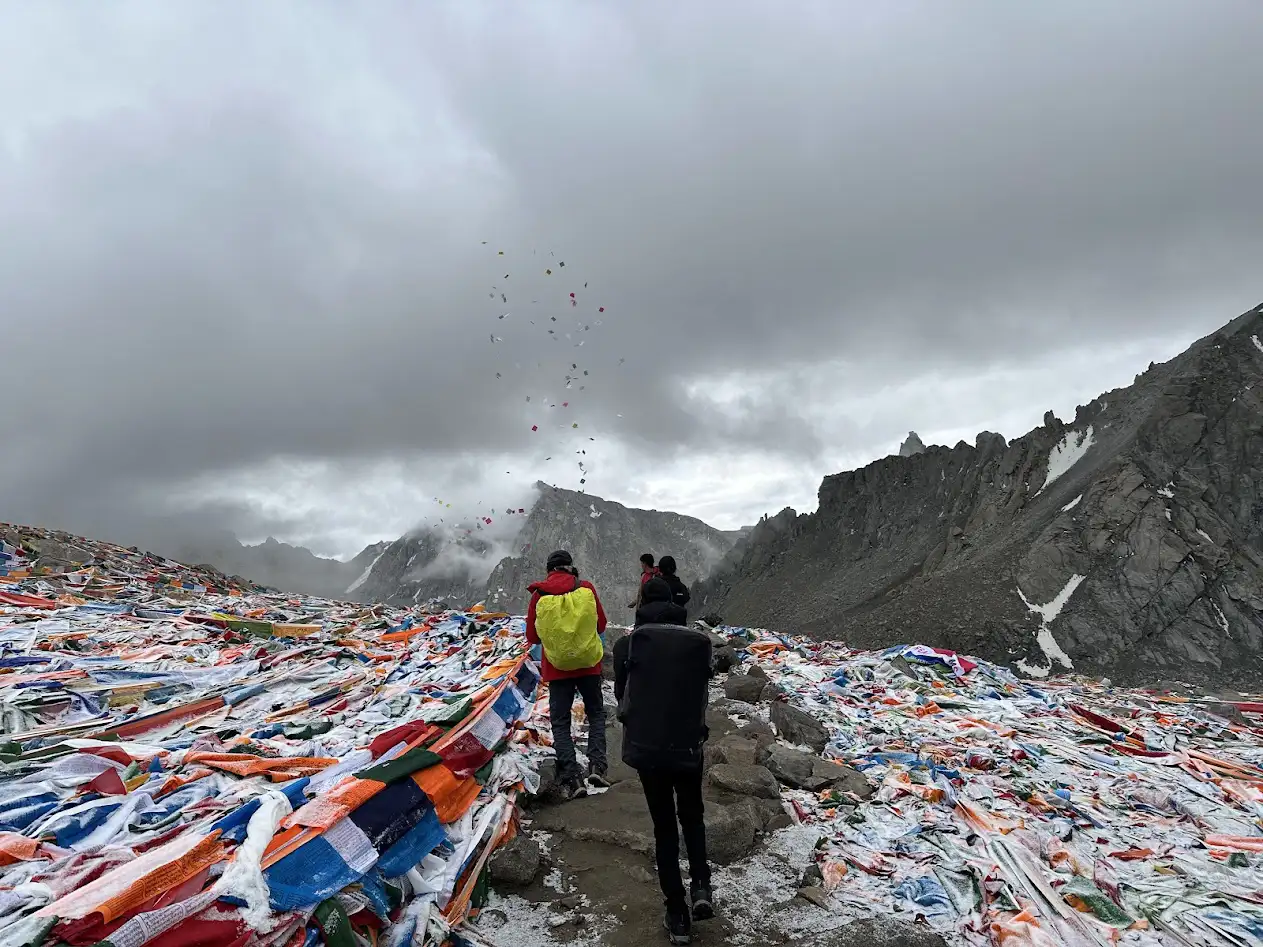
Weathering the Elements
The trek to Dolma La Pass is notorious for its challenging climate, with dramatic variations throughout the year.
- Summer (June-August) is the most popular time to trek, offering milder temperatures and less snow. However, be prepared for afternoon thunderstorms.
- Spring and Autumn (May and September-October) present pleasant weather but can be unpredictable, with occasional snowfall.
- Winter (November-April) renders the pass inaccessible due to heavy snowfall and extreme cold.
Gearing Up for a High-Altitude Adventure
Prepare for the Dolmala Pass trek by taking essential precautions:
- Acclimatize gradually to high altitudes to avoid altitude sickness.
- To stay comfortable as the weather shifts throughout the day, dress in layers that you can easily add or remove.
- Regularly replenish your fluids and consume energy-rich snacks to keep your energy levels up throughout the trek.
- Protect yourself from the intense sun with sunscreen, sunglasses, and a hat.
- Monitor weather forecasts regularly, as conditions can change rapidly.
A Sacred Journey Amidst Challenges
The trek to Dolmala Pass is not for the faint of heart. Its extreme altitude, unforgiving terrain, and fickle weather create a formidable challenge for those who dare to undertake it. However, the rewards are profound. The pass’s spiritual significance and unparalleled scenery make it a life-changing experience for those undertaking it.
Planning Your Trek: Essential Considerations
When planning your trek to Dolmala Pass, keep these key factors in mind:
- Timing: Choose the time of year that best suits your comfort level with altitude and weather conditions.
- Permits: Secure the necessary permits for trekking in Tibet.
- Logistics: Arrange transportation, accommodation, and guides in advance.
- Physical Fitness: Prioritize your physical fitness and ensure you are well-prepared for the rigorous challenges of trekking at high altitudes.
- Respect: Show reverence for the sacredness of the area and respect local customs and traditions.
Dolma La Pass Trek: A Sacred Pilgrimage in the Tibetan Highlands
The Dolma La Pass trek is a unique experience that combines physical challenges with a deep spiritual connection. It’s a high-altitude pilgrimage nestled in the rugged beauty of Tibet, leaving a lasting impact on all who undertake it.
What Awaits You on this Sacred Journey
As an integral part of the revered Mount Kailash Kora, the trek to Dolmala Pass is significant for pilgrims seeking spiritual purification, blessings, and a connection with the divine. This trek is a tour of both the body and the soul. Here’s what you can expect:
- Test Your Limits: The trek demands a good level of physical fitness. High altitudes, steep climbs, and unpredictable weather will push you to your limits.
- Embrace the Spiritual Atmosphere: Prayer flags, mani stones (carved with mantras), and chortens (Buddhist shrines) guide your path, creating an ambiance of reverence and devotion.
- Marvel at Nature’s Majesty: As one of the most rewarding high-altitude treks in Tibet, the Dolma La Pass trek reveals breathtaking views of Mount Kailash, glaciers, and high-altitude meadows that inspire awe and contemplation.
- Forge Connections with Fellow Pilgrims: Trekking alongside fellow pilgrims fosters camaraderie and a sense of shared purpose.
- Achieve a Personal Triumph: Reaching the summit of Dolmala Pass fills you with a sense of accomplishment. Participate in the traditional practice of leaving an offering and saying prayers.
Charting Your Course: Trek Details
- Route: The traditional Mount Kailash kora begins and ends in Darchen. The trek to Dolma La Pass typically spans two days and covers approximately 22 kilometers (13.7 miles). On day one, ascend gradually to Dirapuk Monastery, while day two challenges you with the climb to Dolma La Pass before descending to Zutulpuk.
- Duration: Most trekkers complete the kora in three days, allocating one day for acclimatization and rest in Darchen.
- Difficulty: The trek to Dolmala Pass is challenging due to its high elevation and demanding terrain. Acclimatize properly and prepare for the physical challenges ahead.

Preparing for a Successful Pilgrimage
- Acclimatize Gradually: Before starting the trek, spend a few days at lower elevations to acclimatize to the thinner air.
- Train Your Body: Regular exercise will build the stamina and endurance necessary for the trek.
- Pack Thoughtfully: Bring appropriate clothing, trekking gear, and supplies for high-altitude conditions.
- Seek Guidance: Hiring a local guide familiar with the terrain and weather can enhance your experience and safety.
- Respect Local Traditions: Be mindful of the area’s spiritual significance and adhere to local customs.
A Tapestry of Tibetan Culture and Spiritual Traditions
The Dolma La Pass trek is a physical challenge and a profound cultural experience. It provides a rare glimpse into the vibrant tapestry of Tibetan beliefs, rituals, and symbolic offerings that have flourished centuries in this isolated and sacred landscape.
Rituals and Practices
Pilgrims undertaking the Dolmala Pass journey participate in diverse rituals and ceremonies to pay homage to the place’s sacredness.
- Prayer Flag Offerings: Colorful prayer flags, adorned with mantras and auspicious symbols, are hung at the pass to spread blessings and good fortune. Pilgrims often add their prayer flags to the existing collection, creating a vibrant and dynamic display of devotion.
- Mani Stone Piling: Mani stones, flat stones inscribed with mantras and Buddhist teachings, are stacked along the trail and at the pass itself. Pilgrims add to these piles to accumulate good karma and contribute to the collective spiritual energy of the area.
- Prostrations: As part of their spiritual journey in Tibet, some pilgrims demonstrate their deep reverence for the sacred site and seek spiritual cleansing by performing full-body prostrations along the path.
- Offerings to Tara: Devotees of Tara, the goddess of compassion, often leave offerings of food, incense, or other symbolic items at the pass to express their gratitude and seek her blessings.
- Silent Reflection: Many pilgrims contemplate quietly at the pass, absorbing the serene atmosphere and connecting with their inner selves.
The Significance of Prayer Flags
Prayer flags hold deep meaning in Tibetan culture and are integral to the Dolma La Pass experience. People believe they carry prayers and mantras to the heavens on the wind, spreading blessings and good intentions across the land.
- Colors: Each color of the prayer flag represents a different element and has a specific meaning: blue (sky/space), white (air/wind), red (fire), green (water), and yellow (earth).
- Mantras: People believe the mantras inscribed on prayer flags invoke the blessings of deities and spiritual energies.
- Symbolism: Prayer flags symbolize the interconnectedness of all beings and the continuous cycle of life, death, and rebirth.
Other Symbolic Offerings at Dolma La Pass
In addition to prayer flags, pilgrims may leave other symbolic offerings at the pass, such as:
- Khatas: White scarves that symbolize purity and respect.
- Tsampa: Roasted barley flour, a staple food in Tibet, is often scattered as an offering.
- Butter Lamps: These lamps, lit with yak butter, symbolize wisdom and enlightenment.
- Hair: Some pilgrims cut a lock of their hair to symbolize sacrifice and devotion.
Gearing Up for the Dolma La Pass Trek: A Practical Guide
The trek to Dolma La Pass weaves spiritual pilgrimage and high-altitude adventure, promising an unforgettable experience. Thorough preparation ensures you tackle the challenges and fully embrace the beauty of this Tibetan landscape.
Preparing Your Body for the Challenge
The trek to Dolmala Pass tests your physical limits due to its high elevation and rugged terrain. Start preparing your body well in advance:
- Build Endurance: Boost your cardiovascular fitness with regular aerobic exercises like hiking, running, or cycling.
- Strengthen Your Muscles: Incorporate strength training to fortify your legs, core, and back, essential for carrying your pack and navigating steep trails.
- Adjust to Altitude: Before the trek, gradually ascend to higher altitudes to allow for acclimatization and reduce the risk of altitude sickness.
Pack Smart for Your Trek
Bringing the right equipment is essential to ensure a successful trek. Here’s what you’ll need:
- Clothing: To prepare for changing weather, pack versatile clothing like base layers, fleece, an insulated jacket, and a waterproof shell. Remember a warm hat, gloves, hiking pants, shorts, moisture-wicking socks, and sturdy hiking boots.
- Essential Gear: Bring a backpack (50-60 liters), a cold-weather sleeping bag, a sleeping pad, a headlamp or flashlight, and trekking poles.
- Supplies: Pack enough water bottles or a hydration bladder, water purification tablets or a filter, high-energy snacks and meals, a first-aid kit, sunscreen, sunglasses, and cash (Chinese Yuan).
Navigating Travel Requirements
Traveling to Tibet requires specific permits and adherence to regulations.
- Tibet Travel Permit: All foreign travelers must obtain a Tibet Travel Permit from the Tibet Tourism Bureau.
- Alien’s Travel Permit: If you plan to venture beyond Lhasa, you’ll also need an Alien’s Travel Permit.
- Organized Travel: Tibet does not permit independent travel. You must join an organized tour group or hire a private guide.
- Booking Through an Agency: Travelers must make all travel arrangements through a registered Tibetan agency.
Preserving a Sacred Landscape in the Face of Challenges
The sacred landscape of Dolma La Pass faces the challenge of balancing its spiritual significance and natural beauty with the increasing number of visitors. Local communities and international organizations are stepping up to protect this fragile environment and rich cultural heritage.
Environmental Challenges: A Delicate Balance
The high altitude and pristine environment of Dolmala Pass make it particularly vulnerable to human impact. Key concerns include:
- Waste Management: Trekkers and pilgrims generate waste that threatens to pollute the pristine environment. We can address this through proper waste management systems and educating visitors.
- Erosion Prevention: Foot traffic and weather patterns can cause soil erosion in this delicate ecosystem. We can mitigate this through trail maintenance and promoting sustainable trekking practices.
- Climate Change Mitigation: Rising temperatures and shifting weather patterns endanger the fragile ecosystem, impacting glaciers, water sources, and plant life. We must address climate change to protect this unique environment.
Preserving Cultural Traditions
Dolma La Pass is more than just a natural wonder; it’s a cultural treasure. Protecting its heritage requires:
- Respect for Sacred Sites: To preserve the spiritual landscape, we must treat prayer flags, mani stones, and other sacred objects with reverence and avoid disturbance.
- Empowering Local Communities: We can involve local communities in conservation efforts, ensuring their traditions and knowledge guide sustainable tourism practices.
- Promoting Cultural Understanding: Educating visitors about Tibetan culture and traditions fosters mutual respect and encourages responsible tourism.
Protecting Dolma La Pass: A Collaborative Effort
Various groups are working tirelessly to safeguard the Dolmala Pass:
- Tibet Environmental Protection Association: This local organization spearheads initiatives to educate about environmental concerns and promote sustainable tourism practices.
- Tibetan Plateau Project: This international initiative focuses on research and conservation to protect the Tibetan Plateau’s unique biodiversity.
- Responsible Travel Organizations: Many tour operators champion responsible tourism by educating travelers about cultural sensitivity and minimizing environmental impact.
Your Role in Protecting Dolma La Pass
As a visitor, you have a vital role to play in safeguarding this sacred place:
- Leave No Trace: Pack all your trash and minimize your environmental impact.
- Stay on the Path: Stick to designated trails to prevent erosion and protect delicate plant life.
- Honor Local Customs: Learn about and respect Tibetan traditions and customs.
- Support Local Efforts: Consider donating to organizations that preserve the Dolmala Pass.
Voices from Dolma La Pass: Stories of Transformation and Triumph
The trek to Dolma La Pass is more than a physical endeavor; it’s a pilgrimage that etches itself onto the hearts and minds of those who dare to walk its hallowed path. Here, we recount the experiences and wisdom shared by fellow adventurers who have conquered this high-altitude challenge and unearthed profound spiritual meaning.
Voices from the Summit: Stories of Growth and Gratitude
- Tenzin, a Tibetan Buddhist monk: “The trek to Dolmala Pass tested my faith and pushed my endurance to its limits. The thin air and steep inclines were a struggle, but the strength I drew from the prayers and mantras I recited along the way carried me through. Reaching the summit overwhelmed me with gratitude and a renewed sense of purpose in my spiritual practice.”
- Anjali, a Hindu pilgrim from India: “Crossing Dolmala Pass was an intensely emotional experience, fulfilling a lifelong dream of completing the Mount Kailash kora. I felt a profound connection to my faith as if the landscape pulsated with divine energy. It was a tour of self-discovery and surrender.”
- David, an adventure seeker from the USA: “Even though I’m not religious, the trek to Dolma La Pass was a life-altering experience. The raw beauty of Tibet, the physical challenge, and the camaraderie with fellow trekkers from around the world forged an unforgettable bond. I returned home with a newfound appreciation for the power of nature and the human spirit.”
- Yangchen, a local Tibetan guide: “Each tour I guide across Dolmala Pass is unique. Witnessing these pilgrims’ determination, faith, and transformation fills me with pride and humility. It is a sacred place where people from all walks of life converge to connect with something far greater than themselves.”
Themes That Echo Across the Pass
These diverse stories share common threads that define the Dolma La Pass experience:
- Confronting Physical Challenges: The high altitude and demanding terrain test the limits of even seasoned trekkers.
- Spiritual Awakening: The sacred landscape, adorned with prayer flags and mani stones, inspires reverence and deep spiritual connection.
- Shared Journeys: The shared experience with fellow pilgrims fosters camaraderie and mutual support.
- Personal Transformation: Many pilgrims experience profound personal growth, increased self-awareness, and a strengthened connection to their faith.
Inspired by the Stories of Others
Tales from those who’ve conquered the Dolma La Pass inspire and prepare future pilgrims. Their experiences offer invaluable insights into this high-altitude adventure’s challenges, rewards, and life-changing potential. Whether you seek spiritual growth, a physical test, or an extraordinary tour, the trek to Dolma La Pass promises to push your limits, enrich your soul, and create lifelong memories.

